
Standing Royal Navy deployments is a list of operations and commitments undertaken by the United Kingdom's Royal Navy on a worldwide basis. The following list details these commitments and deployments sorted by region and in alphabetical order. Routine deployments made by the Navy's nuclear-powered submarines and their location of operations is classified.

HMS Enterprise, the tenth ship to bear this name, is a multi-role survey vessel - hydrographic oceanographic (SVHO) of the Royal Navy. She has a sister ship, HMS Echo, and together they make up the Echo class of survey vessels.
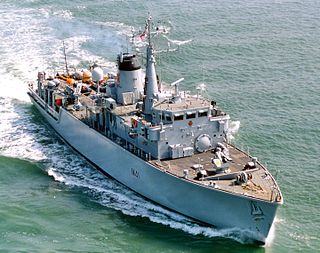
The Hunt class is a class of thirteen mine countermeasure vessels of the Royal Navy. As built, they combined the separate roles of the traditional minesweeper and that of the active minehunter in one hull, but later modifications saw the removal of mine-sweeping equipment. They have a secondary role as offshore patrol vessels.

The Sandown class is a class of fifteen minehunters built primarily for the Royal Navy by Vosper Thornycroft. The Sandown class also serve with the Royal Saudi Navy and the Estonian Navy. The first vessel was commissioned into Royal Navy service on 9 June 1989 and all the British ships are named after coastal towns and cities. They have a secondary role as offshore patrol vessels.

The Commander-in-Chief Fleet (CINCFLEET) was the admiral responsible for the operations of the ships, submarines and aircraft of the British Royal Navy from 1971 until April 2012. The post was subordinate to the First Sea Lord, the professional head of the Naval Service. In its last years, as the Navy shrank, more administrative responsibilities were added.

Standing NATO Mine Countermeasures Group 1 (SNMCMG1) is a North Atlantic Treaty Organisation (NATO) standing mine countermeasures immediate reaction force. Its role is to provide NATO with an immediate operational response capability.

HMS Bangor is a Sandown-class minehunter commissioned by the Royal Navy in 1999. Designed to hunt mines in depths of up to 200 m using the Sonar 2093 Variable Depth Sonar (VDS) meaning that she can conduct mine clearance operations throughout the continental shelf. She is named after the Northern Ireland seaside town of the same name, and the second Royal Navy vessel to bear the name.
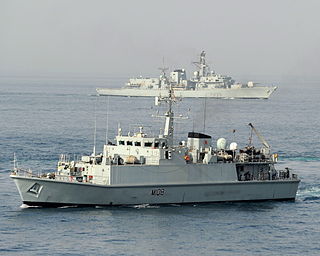
HMS Grimsby was a Sandown-class minehunter of the British Royal Navy, and the second ship to bear the name.
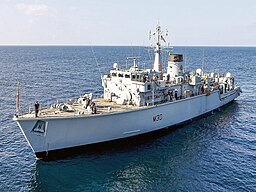
HMS Ledbury, the second ship of the name, is a Hunt-class mine countermeasures vessel of the Royal Navy. She was launched in December 1979 and commissioned on 11 June 1981, the second ship of her class. She cost £65 million at time of building, which was at the time the most expensive cost-per-metre for any class of ship built by the Royal Navy. Most of this cost went into the research and development of Ledbury's glass reinforced plastic hull.

HMS Cattistock, the third ship of this name, is a Hunt-class mine countermeasures vessel of the Royal Navy. She was launched in 1981 and commissioned on 5 March 1982, the third ship of her class.

HMS Pembroke is a Sandown-class minehunter of the Royal Navy. She was the second ship launched of the second batch of the class, which had several improvements over the first five ships built. The ship was posted for three years to the Persian Gulf between 2009 and 2012. Pembroke has since been deployed in international exercises and in historic ordnance detection in home waters. Pembroke was the first of the Royal Navy’s Mine Countermeasures Vessels to be fitted with the Oceanographic Reconnaissance Combat Architecture combat system to replace the previous NAUTIS combat system in early 2020.

HMS Shoreham was a Sandown-class minehunter of the British Royal Navy. She was the fifth vessel to bear the name. From 2018 to 2021, Shoreham was deployed at UKNSF Bahrain together with three other mine countermeasures ships as part of 9 Mine Countermeasures Squadron on Operation Kipion. In 2022 she was decommissioned and is to be transferred to Ukraine.

HMSInverness(M102) was a Sandown-class minehunter of the Royal Navy. She was decommissioned by the Royal Navy in 2005, and in 2008 became EMLSakala(M314) of the Estonian Navy.

HMS Brocklesby is a Hunt-class mine countermeasures vessel of the British Royal Navy, her primary purpose is to find and neutralise sea mines using a combination of; Sonar, Mine Clearance Divers and the Seafox remotely operated vehicle (ROV). The class are the largest warships of glass-reinforced plastic (GRP) construction, which gives the vessels a low magnetic signature. In addition to her mine countermeasures activities, Brocklesby acts as an offshore patrol vessel, undertaking coastal patrol and fisheries protection duties.
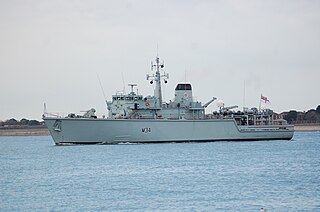
HMS Middleton is a Hunt-class mine countermeasures vessel of the British Royal Navy. As of 2021, she forms part of Nine Mine Countermeasures Squadron operating out of HMS Jufair in Bahrain.
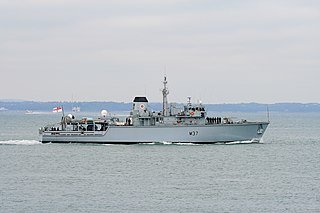
HMS Chiddingfold is a Hunt-class mine countermeasures vessel of the British Royal Navy. She was launched in October 1983 by her sponsor, Lady Anne Kennon, and formally entered the service of the Royal Navy in October 1984. Chiddingfold is a minehunter, and her purpose is to find and destroy mines, not only in a time of war but also in peacetime. There are about a quarter of a million mines still active from the Second World War alone and they pose a major threat to both military and civilian ships. Chiddingfold is able to enter some types of minefields without the mines detonating. This is because she is made of glass-reinforced plastic and all fixtures within the ship are made of non-ferrous metals, keeping the ship's magnetic signature to the bare minimum.

HMS Atherstone was a Hunt-class mine countermeasures vessel of the Royal Navy, the third ship to bear the name. Built by Vosper Thornycroft shipbuilders at Woolston, Southampton, it was launched on 1 March 1986 by Amy Jarvis, the wife of Pat Jarvis, CB, the Deputy Controller of the Navy at the Ministry of Defence, and commissioned on 17 January 1987. It was the tenth ship of its class.
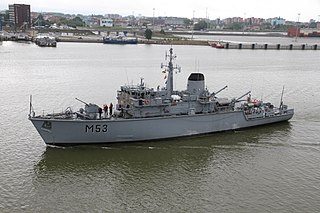
HMS Cottesmore was a Hunt-class mine countermeasures vessel of the British Royal Navy, launched in 1982 and converted in 1997 into a patrol vessel. The ship was declared surplus to requirement and put on the MoD list for disposal in 2004. In 2008 she was bought by Lithuania, along with Dulverton.

EML Admiral Cowan (M313) is a Sandown-class minehunter. Formerly HMS Sandown, lead ship of her class of the Royal Navy, she is now an Estonian Navy ship. Renamed EML Admiral Cowan, she is the flagship of the Estonian Navy and part of the Estonian Navy's mine sweeping flotilla. Admiral Cowan is the lead vessel of the Estonian Navy Mineships Division and also the first of the three modernised Sandown class minehunters received.
In 1989 the Royal Navy was under the direction of the Navy Department in the UK Ministry of Defence. It had two main commands, CINCFLEET and Naval Home Command.



















